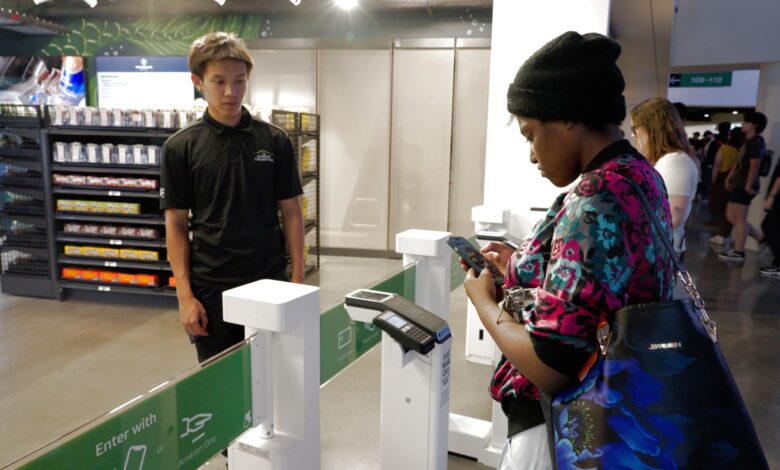Amazon is betting big on selling cashierless technology to outside retailers

In 2012, Amazon founder Jeff Bezos asked by TV host Charlie Rose questions whether his e-commerce company will ever venture into brick-and-mortar stores. Bezos said shoppers are well served by existing brick-and-mortar retailers and that Amazon isn’t interested in launching a “me-too” product.
“We wanted to do something uniquely Amazon,” Bezos said. “If we can find that idea, and we haven’t found it yet, but if we can find that idea, we would love to open physical stores.”
Six years later, Amazon is working on a revolutionary retail concept that it hopes will change the way people shop at brick-and-mortar stores. Company debut Their first Amazon Go convenience store features a new type of technology, called “Just Walk Out.”
In fact, customers can load their items into their carts and exit the store without having to wait in line to pay. Amazon soon brought cashierless checkout to Fresh supermarkets and two Whole Foods locations. in 2020The company began licensing Just Walk Out technology to third parties, signing deals with retailers in stadiums, airports and hospitals.
But since then the company has taken a turn.
In April, Amazon announced it is eliminating cashierless checkout from its US Fresh stores and Whole Foods locations, a move that coincides with a stance from CEO Andy Jassy Efforts to contain costs to respond to rapidly changing macroeconomic conditions.
As part of that effort, Amazon is also reassessing its retail plans. Company stop working some of its retail chains, closing eight Amazon Go storesand hit pause on the opening of the new Fresh store. Its debut several new Fresh stores in recent months.
In place of Just Walk Out, which typically requires ceiling-mounted cameras, shelf sensors and gate entry points, Amazon Fresh stores and Whole Foods supermarkets will feature Dash Carts. The cart tracks and tallies items as shoppers place them in their bags, helping people avoid waiting in line to check out. Amazon continues to use Just Walk Out in supermarket takeaways and UK Fresh stores.
A woman uses a cart while shopping for groceries at a Whole Foods store as Amazon launches smart carts at Whole Foods stores in San Mateo, California, U.S. on February 25, 2024. Smart carts make grocery shopping faster by allowing customers to scan products right into their cart as they shop and then skip the checkout line.
Tayfun Coskun | Anadolu | Getty Images
Jordan Berke, founder and CEO of retail consulting firm Tomorrow, said the main challenge for Amazon and other startups working in the automated payments space is the need to scale to enough locations and retail categories that it becomes a natural part of in-store shopping.
“Until that happens, it’s an uphill battle,” Berke said. “The providers of this technology, including Amazon, are going to have to subsidize and continue to invest in educating retailers, educating consumers, educating the marketplace, that this is a common experience that all We can both trust and not have to think like us.” going in and out of the store.”
‘The most difficult problem to solve’
At one point Amazon saw Just Walk Out become one core part about the shopping experience at its physical stores. The company in 2018 planned to open up to 3,000 Amazon Go stores within a few years, Bloomberg reported at the time, citing people familiar with the plans.
Bezos has assigned top talent across the company, including a longtime Amazon executive who built the first Kindle e-reader, to work on walk-in payments. cashier. The technology is seen as a key component of Amazon’s long-term goal to become a giant in the $1.6 trillion US grocery market.
When Amazon launched Just Walk Out in January 2018, it was a “shocking moment” for the industry, causing Walmart and “most other retailers” jumped into action and considered developing payment systems based on their own vision, said Berke, who previously led Walmart’s e-commerce business at China, said.
Amazon and other retailers soon realized that automating the checkout process was “the hardest problem to solve,” Berke said. Cashierless checkout systems require a huge upfront investment to equip stores with overhead cameras and hire staff to label and review shopping data.
“That means a store has to significantly increase its sales to repay that investment,” Berke says.
Walmart teams realized during a cost analysis in early 2019 that it would cost a retailer $10 million to $15 million to create a vision-based checkout system, Berke said. analog computer for a 40,000 square foot supermarket.
Just Walk Out also became an expensive project for Amazon. In 2019 and 2020, the company spent about $1 billion each year, including research and development costs and capital expenditures, to “understand and scale” the technology, Berke said. He said those figures were based on discussions with the former Just Walk Out executive, who left Amazon to join Walmart. Amazon did not comment on these figures.
Many retailers have moved from computer vision to simpler methods like mobile payments through an app, Berke said.
Walmart uses a self-checkout application in its stores, while supermarket chain Kroger tested with Instacart’s Caper connects shopping carts at several locations. Retailers like it Target And common dollars To be Rethink self-checkout whole due to concerns about increased theft in their stores and has added more traditional checkout lanes.
While it no longer features Just Walk Out prominently in its stores, Amazon said it has signed deals with a growing list of customers. More than 200 third-party stores have paid Amazon to install the cashierless system. The company hopes to double the number of third-party Just Walk Out stores this year, Jon Jenkins, who previously served as Amazon’s vice president of Just Walk Out technology, said in an interview. recently. Jenkins left Amazon at the end of September to become chief technology officer of electric bike and scooter startup Lime. LinkedIn page.
Jon Jenkins, former vice president of technology for Amazon’s Just Walk Out, tours a convenience store model where the company tested a cashierless checkout system in Seattle, Washington, on August 22, 2024.
CNBC
Jenkins disputed characterizations that Amazon’s phasing out of Just Walk Out from its own supermarkets was a step backwards or Signs of technological collapse. Amazon has demonstrated through tests in its grocery stores that the technology is “incredibly capable,” he said, noting that it has deployed the system in supermarkets large with “600 people present in the store at the same time”.
Other startups like AiFi and Grabango have developed automated systems for supermarkets, convenience stores and other retailers, but widespread adoption has been slow because the technology remains expensive and difficult. Operate in large stores.
Inside the laboratory
Amazon is still refining its Just Walk Out technology.
In August, CNBC got its first on-camera look at a simulated convenience store, where Amazon tested the system before rolling it out at third-party retailers and its own stores.
The testing lab they call “beverage base camp” is located at Amazon’s headquarters in Seattle. It features fake gates that mimic the experience of scanning your smartphone or credit card to enter a Just Walk Out store. The walls are lined with shelves of typical takeaway products like Milky Way bars, pita chips and gum, and there are refrigerators filled with Cocacola cans and other drinks.
Amazon sets up Just Walk Out stores by first creating 3D scans using a LiDAR machine or an iPad to help it determine where to place cameras so they have the clearest view.
“The goal was to have the fewest number of cameras possible, so we optimized camera placement so we could get enough coverage on each fixture to see what was happening in the room,” Jenkins said. shop”.
The system determines what shoppers have purchased using a number of inputs, including 3D scans, catalog product images, video footage and shelf weight sensors. Amazon in July updated AI system behind Just Walk Out technology to process all inputs in the store simultaneously.
The new “multimodal” system can generate receipts faster by more accurately predicting which items shoppers have picked up and put back on shelves. The company said the changes will help retailers install the system in their stores “faster, easier to deploy and more efficient.”
Amazon’s “main focus” is selling the technology to third-party businesses and deploying it in small and mid-sized store formats, where the system “tends to generate slightly better margins.” [return on investment]”, Jenkins said. Earlier this year, Amazon also started selling third-party connected grocery cart.
Amazon in September announced several new third-party Just Walk Out stores at universities and sports stadiums.
CNBC
At a Just Walk Out store, inside Seattle’s Lumen Field, home of the NFL’s Seahawks, the company said it increased sales by 112% last season, with 85% more transactions in throughout the course of the game.
“It’s great that we have our own stores as labs to build and launch this product,” Jenkins said. “But over time, like many things at Amazon, the success of this project and product will depend on third-party adoption of the technology. There will always be more third-party stores in the world than there are first-party stores.”
Amazon has used a similar playbook in the past. Amazon Web Servicesthe company’s hugely successful cloud computing unit, which stemmed from the company’s need for IT infrastructure to support its rapidly growing online retail business. And in recent years, Amazon has leveraged its logistics and fulfillment network to offer services to third parties.
With Just Walk Out, Amazon faces the challenge of convincing retailers that they can trust one of their biggest competitors to handle valuable shopper data.
In 2022, Amazon moved the team behind Just Walk Out from its retail organization to AWS. It marks one of the clearest signals yet that Amazon is serious about selling the technology to other retailers and could help alleviate some concerns among rivals.
“They are clearly in sales mode,” Sucharita Kodali, a retail analyst at Forrester Research, said in an interview.
Kodali said Amazon still has “a long way to go” before the technology becomes widespread. Getting there will require patience from Amazon’s investors, and data shows that both retailers and shoppers are embracing the technology.
“There’s almost a ripple effect that happens over time,” she said. “It’s going to take a long time because you have to go through everyone in America having this experience and for the most part, it’s just Amazon that’s fighting this fight right now.”
Watch the video to see behind the scenes of Just Walk Out:




